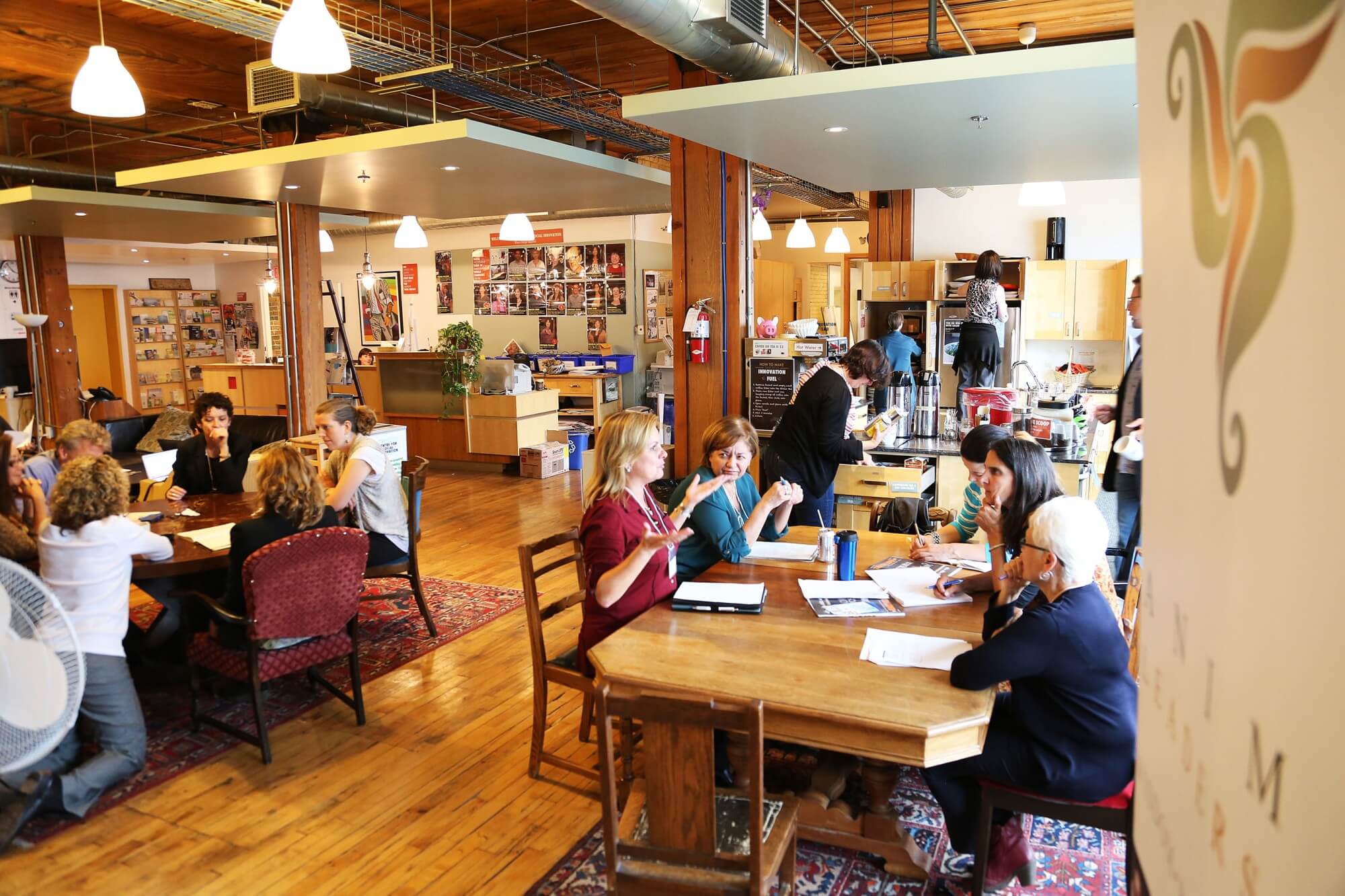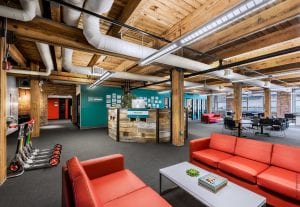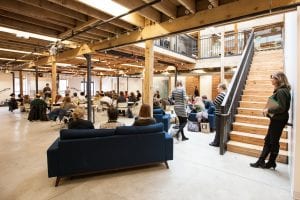
CSI’s former space at 215 Spadina in Toronto. Courtesy of Centre of Social Innovation
When I lived in Toronto, I worked for an organization that made its home at the Centre for Social Innovation (CSI), a shared space for nonprofits, charities, and social ventures. When I arrived, CSI was in its fledgling days and the Centre had recently opened. It had around 8,000 square feet and was home to just a few organizations.
It was great to participate in the burgeoning space as the tenant community gelled and the management team explored how to meet the needs of the organizations that made CSI their home. Today, CSI operates well over 100,000 square feet in Toronto and New York.
As someone who has spent much of their working life in nonprofits and studying nonprofit management, I was quickly hooked on this model of shared space that looks to create efficiencies through shared amenities (like conference rooms, kitchens) and shared office services (like reception, copy center) and to bolster effectiveness through peer learning and collaboration between tenant community members.
I left Toronto, but my interest in shared space continued. I ended up in San Francisco working for Tides. There I started as part of its Nonprofit Centers Network (NCN) program staff before joining Tides’ real estate team to help run the Thoreau Centers (now called Tides Converge). Tides’ first undertaking into shared space was a 150,000-square-foot adaptive reuse project made up of 12 old military hospital buildings in San Francisco’s Presidio, which is now home to nearly 80 organizations. Later, Tides led a 25,000-square-foot office condo project in Lower Manhattan that created ownership opportunities for four organizations and rental space for many more.
Centers like CSI and Tides Converge are dynamic communities made up of organizations and people working to make the world a better place. They are often created to provide below-market and stabilized rents, reduce costs and/or increase quality through sharing, and sometimes to foster new collaborations. Aside from providing vital infrastructure, putting everybody together under one roof helps to break down silos, creates a place for sharing stories, and provides opportunities for people to informally learn from one another as they tackle the challenges of running their organizations.

Lobby of the Literacenter in Chicago. Courtesy of the Chicago Literacy Alliance
Nonprofit centers come in a range of sizes and with different areas of focus. They can be home to just two or three organizations or they can be large facilities with dozens of tenants. They can be co-working spaces, administrative offices, social service hubs, or shared arts and culture facilities. They can have a single nonprofit or foundation as owner that rents to other organizations, or have shared ownership structures like an office condo building. They can look to serve a specific mission theme (like the Alliance Center in Denver focused on sustainability or the Literacenter in Chicago focused on literacy) or be more generalist in their tenant selection. Regardless of the form they take, most nonprofit centers operate as mission-driven spaces.
Given the infrastructure and space challenges that many nonprofits face, I’m hopeful for what these centers can offer as a platform for organizations to come together to achieve more than each one can on their own. While getting to deep collaboration between members of shared space can be a journey (often a hope, but not always a destination), along the way nonprofit centers strengthen their community members by providing secure space, access to business systems, and important neighborhood infrastructure.
To better understand these spaces and how they achieve their impact, it’s helpful to think of them in layers: the building as an asset, the building as a program, and the building as a platform for collaboration. These layers work together to support tenants in better achieving their missions.
At their core, nonprofit centers are commercial real estate. Operators of these facilities must think of the building as an asset and as a workplace. The building as an asset means that it must meet the financial objectives of the owner(s), have solid daily operations and professional leasing, and a long-term plan to meet the property’s capital needs.
The building as a workplace must be responsive to a changing workforce, including in its design, amenities, and technology that enhance employee performance, engagement, and wellness. Regardless of the kind of nonprofit center being run, operators need to get these two core functions right, and when done well, they greatly contribute to the overall impact of the building by meeting the tenant community’s basic needs.
The nonprofit center as an asset gives organizations higher-quality space and increased visibility, but that’s just the beginning. What makes nonprofit centers special is the building as a program, particularly the collaborative work that can happen within the spaces as the tenants build trust and begin to take risks with one another to achieve greater impact than they could on their own.
The foundation of programmatic work for most nonprofit centers is to provide security of place for organizations and achieve some level of below-market-rate rent (or reduce occupancy costs/build equity when the center is jointly owned by the tenants as with the Ninth Street Independent Film Center in San Francisco). After that, nonprofit centers often look to create some organizational efficiencies through shared services and amenities. These can include shared conference rooms, kitchen, copier and internet service, reception, and more.
Looking beyond its walls, the building as a program can also mean bringing new community infrastructure, sometimes offering public programs like lectures and forums, being a place for workshops and trainings, acting as a home to visual and performing arts, or providing human services like we find with social service hubs. While these core offerings are key to the success of each tenant organization, they also lay the groundwork for collaborative work between tenants that can spur innovation, build capacity, and scale results.
While programming provides valuable infrastructure and services to a center’s community, the program that offers the most promise to scale impact is a center’s efforts to promote and support collaboration. Nonprofit centers can be a platform for trust building and can move their community members along what the Nonprofit Centers Network calls a continuum of collaboration that moves from networking to coordination to deeper levels of collaboration and shared risk taking.
Networking and Trust Building
It starts at the basic level of the “building as a network,” bringing together members to learn more about one another, build trust, and begin to uncover shared interests and mission overlap. These efforts often take the form of simple social events or sometimes more structured activities. At Tides we held regular social events like happy hour, but also activities like Thoreau Open Your Doors, that invited tenants into each other’s spaces and Take Ten, where tenants gathered for a 10-minute afternoon snack and a short presentation highlighting a tenant.
Coordination and Communication

The Posner Center, a theme center focused on international development organizations. Courtesy of Posner Center
Some centers go deeper by offering opportunities for peer learning and low-risk coordination like cross-referrals and joint volunteer recruitment. These spaces also support increased communication between groups. At the Posner Center, a themed center in Denver that is home to international development organizations, they identified a common need across organizations to increase their ability to measure impact. They collaborated with a local higher education institution to bring in faculty to teach on the topic on an ongoing basis. This allowed for efficiencies (not having to travel to campus, group learning) and reduced cost. It also meant they could build shared metrics to aggregate data across agencies.
Collaboration and Risk Taking
Pairing co-location with trust-building efforts can encourage organizations to take on bigger joint efforts with higher risks and rewards. These collaborative ventures can include joint fundraising, sharing staff, launching new joint programs or any effort where two or more organizations can pool their resources to foresee some new or scaled impact for the people or place they serve. At the Child and Family Services Center in Charlotte, North Carolina, the tenants banded together and hired a joint CFO to bring more sophisticated financial analysis to all their organizations.
Nonprofit centers can provide benefits to their tenant organizations and should be considered as an important community development strategy. By offering a more permanent home and affordable rent, and by easing the administrative load though quality amenities and services, nonprofit centers push the boundaries of what a multi-tenant building means.
But the real power of nonprofit centers is their potential to serve as platforms for robust collaboration and risk-taking between organizations. Fostered by their proximity and supported by center staff, center tenants have a pathway to build trust and learn from one another so they can think bigger and do more together than they could on their own.





This is the first time I’m hearing of such concept and it’s simply amazing! 12 old military hospitals now housing 80 companies, that’s huge!